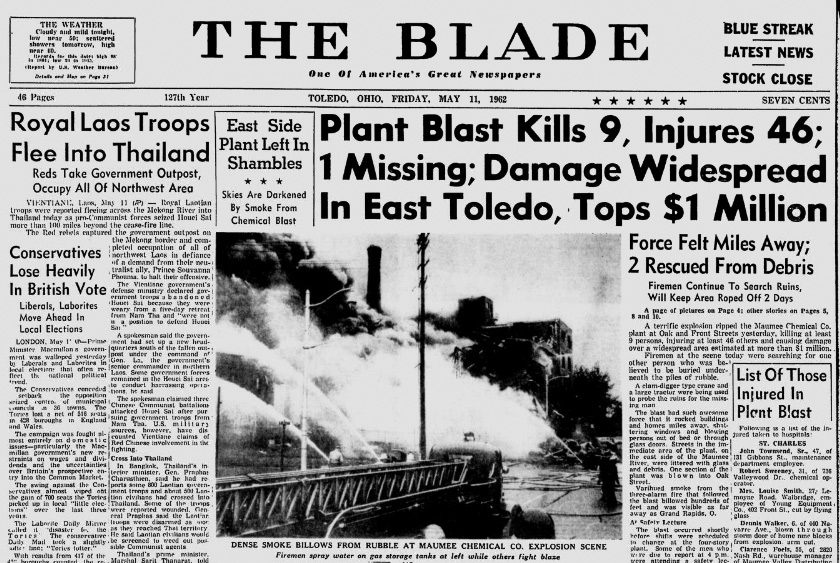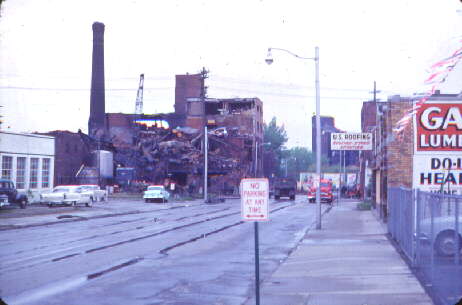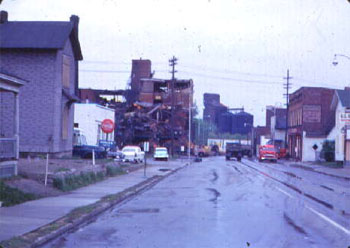
Lying on a stretcher at Riverside Hospital, Maumee Chemical Co. employee Van R. Porter of Stony Ridge recalled he was in a safety meeting, discussing procedures for working inside tanks when a warning of fumes escaping at the plant went off. The group went to a prearranged place, the cafeteria, but finding no one there, Porter went outside just as a massive explosion ripped through the former Koerber Brewery facility at Oak and Front Streets.
The explosion, shortly after 3:30 p.m. on May 10, 1962, killed ten and injured 46.
Porter was lucky he went outside. Of the twelve men in the cafeteria at the time of the explosion, five died, two were rescued, and the others escaped on their own.
Anyone living on the east side of Toledo in 1962 would probably remember where they were when the explosion occurred, as the damage was not limited to the plant itself. “The blast had such awesome force that it rocked buildings and homes miles away,” The Blade wrote, “shattering windows and blowing persons out of bed or through glass doors. Streets in the immediate area of the plant, on the east side of the Maumee river, were littered with glass and debris.”
Some East Toledoans thought it was an airplane crash. Others thought it was an atomic bomb. The injury reports came from a wide area: A 20-year-old woman was blown out of her bed a quarter mile from the explosion. A woman on Second St. was admitted to Mercy Hospital with cuts; she was in her kitchen at home when a window was blown out. A 6-year-old boy received cuts after being blown through a storm door at his home, nine blocks from the explosion, on Navarre Ave. Downtown, a Lakewood Ohio man, distracted while looking up at the explosion, drove through a stop sign at Ontario and Locust streets and hit another car. A 20-year-old woman collapsed from shock in front of Tiedtke’s on Summit St.

“Store fronts, windows and signs were shattered in a five-block area surrounding the plant and glass was ankle-deep in some buildings and on the sidewalk at Oak and Front Streets, also helping to give the scene the look of a target of aerial bombardment,” wrote The Blade’s Stuart Saunders, who was witness to some of the bombardment in London during World War II.
“There was a violent vibration,” A.M. Kostoff of 414 Second St., said. “I ran out the back door on an impulse. There was a mushroom of smoke, not unlike a bomb you see in the movies. But I knew what had caused it. This is the second or third explosion at the plant and that was the first thing I thought of.”
And indeed, it was not. A November 1954 explosion caused $100,000 in damage. The 1962 damage was estimated at over $1 million.
Three days later, as gawkers streamed by to view the wrecked building, company officials said the explosion was most likely caused by acrylic polymer, a compound used in plastics, Another possibility was a combination of chemicals or vapors that caused the blast. Toledo Fire Chief Arnold Papenhagen said he was “inclined to go along with the company’s explanation,” but it was eventually determined that a 750 gallon tank of xylene overheated and released enough volatile fumes to trigger the explosion, according to this article from fireengineering.com, which also has some great photos from the Fire Prevention Bureau.
In 2016, however, in an article about the development of saccharine by Maumee Chemical and its Toledo-born inventor, Oliver F. Senn, The Blade said:
Fire investigators never ruled on the cause of the May 10 explosion, at least publicly. But Mr. Senn purportedly knew what had happened.
According to his son-in-law, Mr. Senn was told that a veteran plant foreman had mistakenly removed the lid of a ball mill, a type of grinder that contained hundreds of ball bearings used for grinding material into fine powder. Mr. Senn knew the foreman, who was killed instantly. The ball mill was unrelated to saccharin production.
“It went off like a bomb,” Mr. [Bill] Pitt said.
The company president, George Schlaudecker, told The Blade a few days later he had not determined whether the company would rebuild the plant, but ultimately it did not. According to Schlaudecker’s 2011 obit, the company relocated manufacturing but kept offices in Toledo.
Maumee Chemical also was known for developing a chemical to kill lamprey eels, which were intruding on the fish population of the Great Lakes at the time.
The East Toledo Historical Society has some interesting photos on their Facebook page.

Is there any way I could get a copy of this story? I was born in Toledo and was there during this time. We loved a block from this explosion.